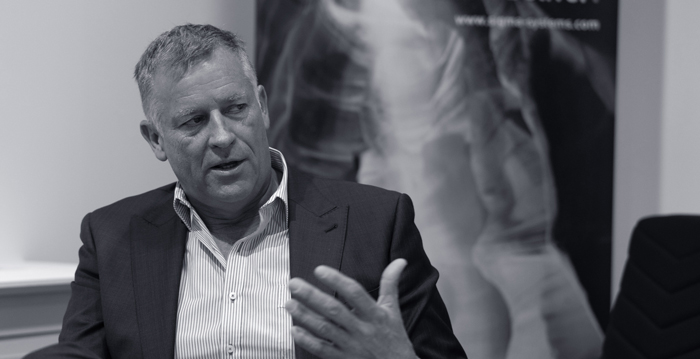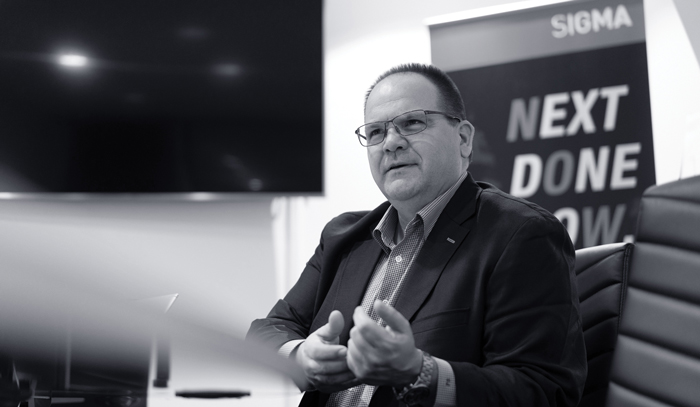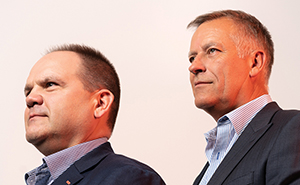The recent acquisition of Sigma Systems by Hansen Technologies (https://bit.ly/2HhekRI) took the telecom market by surprise, as the Australia-based IT vendor put US$117 million down in cash to acquire 100% of global software provider, Sigma. A few days later, the CEOs of both companies met VanillaPlus in London to talk candidly about reasons for the deal, what it means for customers, and where the business support systems (BSS) market is heading – and not just in telecoms.
Jeremy Cowan, VanillaPlus: Andrew, what was it you were looking for when you started the acquisition conversation with Tim?
Andrew Hansen, Hansen Technologies: Hansen’s business over the last year 30 years has expanded by acquisition. We started doing billing services about 25 years ago and have stuck to our core competency in the telco and energy markets.
I’ve known about Sigma for a number of years and we’ve seen it as a good strategic fit. The ideal opportunity to talk acquisition came when Tim (Spencer, Sigma’s CEO) and the board decided to put some feelers out to gauge interest in the business.
What do we like about the business? I think the DNA of Sigma is similar to Hansen, it’s built upon the same sort of customer service excellence and market focus that Hansen has always demonstrated. Tim’s been in the business since 1996 and I’ve been at Hansen for even longer, and when you come across a business where the tenure of employees is that long, you start to see a parallel commitment to looking after customers. Also the technology, the investment which Sigma has been making, and certainly the modernisation and digitisation, was a huge attraction. You start to see a pattern with businesses that are getting to the end of their time, and Sigma shows none of those signs – it’s really at the very start of the journey.

VP: You’ve acquired nine companies in the last decade. What singled Sigma out? Because there are plenty of companies in this space.
AH: In fairness to Sigma, for the size of the business, some of their recent wins have been significant; their customer base really made them stand out. I think the development of their products and their focus on the cloud was also a factor; it’s a cutting-edge technology, which is what customers want and need. It’s also given us a unique proposition; we can go into companies and add Sigma software alongside heritage systems, so it’s not a case of totally replacing what they’ve already got. It’s a great advantage when you meet someone who’s invested tens of millions of dollars putting infrastructure and systems in, and actually optimise some of that investment rather than saying “you need to throw your applications out”.
VP: Tim, the last time I spoke to Sigma, it was indicated that Sigma was looking at all sorts of options. Acquisition by another party was one, but another was to grow yourselves. What made acquisition by Hansen the better option?
Tim Spencer, Sigma Systems: We’ve been on a similar journey, looking for opportunities to acquire companies. When we started thinking about what the next evolution of Sigma would look like, there were a couple of different pillars to it. First and foremost, we wanted to continue to drive our cloud-first strategy. We wanted to continue to diversify our customer base, and scale through penetration into some new industry verticals, beyond the telco vertical, which we’ve had a lot of success in, and when we first engaged with Andrew and his team it checked a lot of those boxes. The combination of the two companies also drove scale, which is important. Being successful, competing with large players and having that scale and breadth of IP across a larger segment of the technology spectrum that is relevant to our customers was important. We’re wholly aligned on our cloud-first strategy as well, as both our solutions and our customers’ needs are heading that way.
Realising the vision of taking our products into these other verticals, something that Andrew’s done a great job of with his team, and expanding beyond telco into the energy, utility and pay-TV space successfully, felt like a long journey on our own. It’s something that can be done fairly rapidly through acquisitions but is difficult to achieve organically, so we started looking for acquisitions along that line. We found ourselves in this process, and it checked all the boxes, ultimately being the Acquired as opposed to the Acquirer, gives us an even larger scale than we anticipated. It makes us an even more formidable competitor in the marketplace with greater scale and depth, but nimbler than the other large-scale B/OSS providers in the industry.

VP: Andrew, is this acquisition closing a skills gap, a customer gap? Or is it helping you to achieve scale, first?
AH: Primarily scale. Across the two organisations, we have 19 different products now. It’s reassuring for our customers, that not all your eggs are in one basket and you can actually share that experience, which is what Hansen does; we bring all that experience to the table. Significantly, though, some of the work Sigma is doing provides a platform that we can leverage into the energy marketplace. The energy marketplace is undergoing a massive transformation at the moment, with solar power, combatting greenhouse gas emissions, and electric cars. The whole way in which power can be consumed into the future is actually following a much more complex path and product offering.
In the past you bought electricity, you had a peak and an off-peak charge, and that was it. That’s going to change noticeably now, and we can envision leveraging some of Sigma’s technology into that customer base. Sigma brings 480 staff on board with more than two decades of experience to the table. When you sit down with an existing customer and you bring in people with that much specific expertise, it’s a game changer.
VP: Anything you’d add, Tim?
TS: We will remain dedicated to the telco industry collectively. On a combined basis it’s half of the business and we’ll continue to push the innovation that we’ve been doing in the telco industry heavily, as the world moves towards 5G. There is a great opportunity to tap into the 500-plus customers that Hansen has, and bring our technology and CPQ management for end-user provisioning to that customer base.
We’ve already had some wins in the energy space and think we’re going to be able to tap into that fairly rapidly, because customers ultimately want to buy more technology from fewer vendors.
AH: And we have a combined business of over 600 customers and software deployed in 80 countries around the world. That’s an amazing footprint, with nearly 1600 staff.
TS: We’re [Sigma] operating in 25 countries today, and now 80 when combined with Hansen.
VP: I see your combined revenues are forecast to rise from 30% in telco to 48% post-acquisition. That’s a lot of emphasis on telco at a time when not everyone is backing them to be masters of their own future. What about the threat from the FANGs (Facebook, Amazon, Netflix, Google)?
AH: Thirty years ago, 100% of Hansen’s revenue was telco. We actually went into the energy market based on our experiences in the telco industry. We leveraged our telecommunications experience and were then able to go after the energy marketplace as it started deregulating.
When you look at the services provided to households or to businesses now, when you actually focus on phone, internet, gas, electricity and water, most of the challenges facing our customers are with customer churn, optimisation of profit, and agility in new product and service innovation. We’re finding energy companies and telcos starting to get in each other’s space now; there’s energy companies now looking to launch telco, we’ve got pay TV operators now launching to be full blown telcos themselves and the lines between them are increasingly blurred. Hansen and Sigma are perfectly positioned to assist that journey for our customers.
VP: With such a focus on telcos, Tim, what do you see as particular strengths of the combined offering?
TS: The combined offering means an opportunity to address a bigger part of the challenge that our customers are having in everything from product innovation and creation through customer quoting, ordering, right through to revenue management and care. We’ve got a bigger part of the solution that addresses our customers’ needs, that we can bring to the table. And that applies to more than the telco market, when we think about some of that cross-selling opportunity to bring Sigma’s core technology into the hands of the customer base.
We’re seeing a lot of industries, from financial services, to insurance, to utilities to energy, all looking at the telco industry, for a blueprint of how to bring digital services to market, how those digital services are managed across a broad spectrum of channels, how to engage with customers across those channels to facilitate the management of their needs and wants. We’ve seen this in both our existing customer base and some of our more recent wins. A global car manufacturer came to us with Tech Mahindra as a partner, looking at our technology to help them with their connected car service. It’s a very different set of applications but the very same applications, in terms of the technology, for customer quoting, ordering and fulfilment of connected car services. It’s an example of how other industry segments are looking at the telco industry, or how they’re delivering digital services, and looking at the vendors in that space to help enable that.
VP: So, you’re looking particularly at the integrators in Tech Mahindra’s case, rather than specifically telcos.
TS: The catalyst to the connected cars opportunity was actually meeting the global car maker at TM Forum in Nice two years ago. They were looking for a catalog-driven solution for customer ordering and fulfilment of connected car services. In the connected car, there’s hundreds of potential applications, from telemetry to maintenance scheduling, to in-car entertainment services, that will all be part of the experience and the move towards autonomous cars. And that will grow even faster, because soon your hands will be off the wheel and you’ll want to be entertained on your journey. It’s the next living room for those who get stuck in cars for long periods of time.
An energy company came through that same channel, because they were looking at the innovation that is being driven in the telecom industry and trying to replicate some of that experience.
VP: Can you say who that was?
TS: EWE in Germany, actually.
VP: You also forecast greater emphasis on the Americas, with 24% of revenues pre-acquisition and 32% post-acquisition. First, is that mainly North America? Or is it more equally balanced between Latin and North America? And second, are the Americas more attractive to you as a combined operation than APAC or EMEA?
AH: Our products are our children, we love them all equally (laughter). The opportunities in Latin America are going to be phenomenal, because they’ve got a lot of development taking place right now. The North American market’s been a very good market for Hansen for 20 years, and it’s a similar story at Sigma. So, we will be bringing just as much focus to the Americas, as we would APAC or EMEA.
TS: The Americas have been growing well for us over the years. When we started there, it was 100% of our business. We’re seeing a lot of success in Southeast Asia, and ANZ right now as well.
AH: We have focused on each of those regions and have management, delivery management, account management and sales in each.
VP: Tim, what will be your new role in the combined business?
TS: I’ll be CEO of Sigma Systems, a Hansen Technologies company. No change on a day-to-day basis.
VP: Will the rest of the current Sigma Leadership team retain the same positions?
AH: There’s no change. This deal’s only taking place because of the enormous success Sigma’s had in the marketplace, and there was no necessity to change. Tim and I will partner together, championing the businesses throughout, but certainly for any day-to-day responsibilities Tim is continuing to run Sigma.
VP: Andrew, looking at the published figures, there’s US$42 million left in your new bank debt facility. What’s that for?
AH: Hansen’s cash equity management has always balanced between debt, issuing scrip and cash. Sigma is a very strong, cash generative business, like Hansen. We have very low leverage ratios inside the business with this sort of debt on board. But Tim and I are already having conversations about other opportunities.
VP: Do you expect to do anything else this year?
AH: We are looking at opportunities every day of the week. We often say we should be rewarded for the deals we don’t do (laughter). Because you have to kiss a lot of frogs in the marketplace. But it’s not something you rush into, this current acquisition has taken months of gestation for the combined businesses.
VP: You’ve obviously achieved greater scale. Does it matter that competitors like Amdocs, Ericsson and Netcracker are still considerably larger?
AH: Well, you’d probably have to ask our customers that. From a differentiating point of view, we’re a midsize organisation, and that’s an advantage because not everyone wants to be with an Amdocs and be indoctrinated into that process. We’ve got excellent scale with the right amount of flexibility and agility to meet customer needs. Frankly a lot of others just don’t. I also think competition is healthy for all parties; it keeps us and our competitors honest. I think we’re now the size and the scope of organisation where Tier 1 telcos can really trust us, based on the pedigree of our companies, which have been around since 1971. And both companies have excellent relationships with customers.
VP: There’s no particular overlap, surprisingly, in your product portfolio, and not much in your customer base. Does that mean that your emphasis now has to be on R&D to expand and roll out into new areas?
AH: I think the markets which we’re both occupying have an enormous amount of opportunity; the connected car deal we talked about is very interesting to us. The scope and the continual development that the telco and energy markets have for both businesses has decades to run; we’re not ‘end of life’ in either of these marketplaces. From that point of view we’re at the start of the journey.
TS: I’ve been talking to customers over the last week and they see the benefit of the combined portfolio. Had Sigma sold its business to some of the other players mentioned, it would have been of more concern to our customers. In this case, there’s no overlap in the technology space, but there’s some strong synergies between the products. We’re not having to make tough decisions about whose is the better provisioning product, or the better catalogue.
AH: That’s a strong point, that there’s no competing products. It’s just purely complementary.
VP: We hear from telcos worldwide that it’s a challenge to roll out new services quickly. What can you do better now that you are combined to help them achieve rapid time-to-market for new services?
AH: I think you look at the success Sigma’s had recently, the products are already proven – there’s a track record, what we’re doing is demonstrable and referenceable. We’re just a bigger company with more depth of resources now. I think that’s probably the most comforting thing. It’s more staff around the world, and notwithstanding the deep-rooted subject matter expertise inside the products, the broader attributes, around delivery management or testing or account management, can all be shared through the organisation.
VP: Finally, where do you see the best cross-sell opportunities?
TS: The energy and utilities market. They’re going from a product offering which was no more complex than peak and off-peak, to a much broader set of applications. Energy companies are starting to think about the individual applications that are consuming energy and coming up with different pricing schemes based on the application, as opposed to just kilowatt hours.
The utilities are looking at expanding their product sets to include things like services, and boiler maintenance, and other types of applications in-home. Their product sets are getting more complicated and the channels that they’re selling through are expanding with deregulation. As the types of applications and products get more complicated, the whole customer management function around it becomes more complicated.
This is where Sigma’s and Hansen’s product sets really shine with our telco customers. We help them go from cycles several months long to hours or days long. Many of our customers can pick up a newspaper on a Monday, see what their competitor is doing, and by Thursday they’ve got a matching product ready to go. We’ve been doing that for years with companies like Sky, and we are expanding that complexity with customers like Telkomsel in Indonesia. They’re producing upwards of 20,000 new pricing schemes per month, through the platform, with deep micro-segmentation of product and pricing. We’re helping our customers do that today; we’re just looking to help more customers do that over time.






